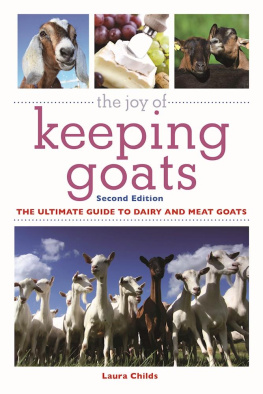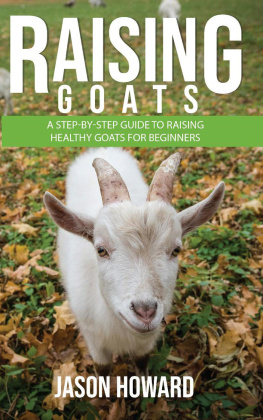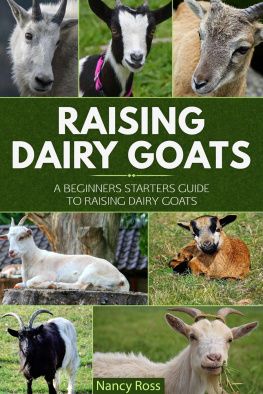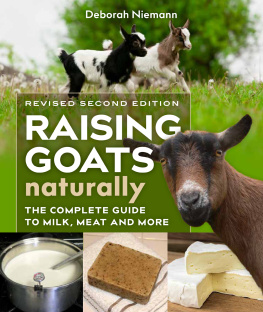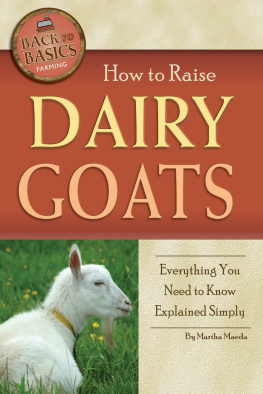STOREYS GUIDE TO RAISING DAIRY GOATS
FOURTH EDITION
Storeys Guide to
RAISING
DAIRY
GOATS
Breeds Care Dairying Marketing
JERRY BELANGER
&
SARA THOMSON BREDESEN

Edited by Sarah Guare
Art direction and book design by Cynthia N. McFarland
Cover design by Kent Lew
Text production by Erin Dawson
Cover photograph by Jason Houston
Illustrations by Elayne Sears, except by Bobbi Angell: page 91 (Johnson grass); Sarah Brill: page 89 (multiflora rose); Beverly Duncan: page 89 (chicory, daisy, nettle, yarrow), page 90 (mountain laurel, oak leaf, wild cherry); Judy Eliason: page 90 (dock); Brigita Fuhrmann: pages 120, 186; Chuck Galey: pages 20, 21, 88; Regina Hughes: page 90 (bracken fern, locoweed, milkweed, sorrel), page 91 (amaranth); Carl Kirkpatrick: pages 69, 71 top; Alison Kolesar: page 89 (plantain), page 106; Mallory Lake: page 90 (rhubarb); Louise Riotte: page 89 (dandelion, thistle); Ilona Sherratt: pages 196199 (design courtesy Countryside & Small Stock Journal)
Indexed by Christine R. Lindemer, Boston Road Communications
2010, 2001 by Jerome D. Belanger
All rights reserved. No part of this book may be reproduced without written permission from the publisher, except by a reviewer who may quote brief passages or reproduce illustrations in a review with appropriate credits; nor may any part of this book be reproduced, stored in a retrieval system, or transmitted in any form or by any means electronic, mechanical, photocopying, recording, or other without written permission from the publisher.
The information in this book is true and complete to the best of our knowledge. All recommendations are made without guarantee on the part of the author or Storey Publishing. The author and publisher disclaim any liability in connection with the use of this information.
Storey books are available for special premium and promotional uses and for customized editions. For further information, please call 1-800-793-9396.
Storey Publishing
210 MASS MoCA Way
North Adams, MA 01247
www.storey.com
Printed in the United States by Versa Press
10 9 8 7 6 5 4 3 2 1
Library of Congress Cataloging-in-Publication Data
Belanger, Jerome D.
Storeys guide to raising dairy goats / by Jerry Belanger & Sara Thomson Bredesen. 4th ed.
p. cm.
Includes index.
ISBN 978-1-60342-580-3 (pbk. : alk. paper)
ISBN 978-1-60342-581-0 (hardcover : alk. paper)
1. Goats. I. Thomson Bredesen, Sara. II. Title. III. Title: Guide to raising dairy goats.
SF383.B44 2010
636.39142dc22
2010022291
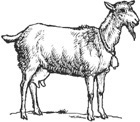
Contents

Basic Information
About Goats
THIS BOOK ASSUMES THAT you are interested in goats and that you like these interesting and valuable animals, but it doesnt assume that you know anything about them. So lets start at the very beginning by looking at some basic terms and facts. (If you already know the basics, or if youre more interested in practical matters than in terminology and history, feel free to skip ahead to the next chapter.)
Basic Terms
Female goats are called does or, if theyre less than a year old, sometimes doelings. Males are bucks, or bucklings. Young goats are kids. In polite dairy goat company, they are never nannies or billies, although you might hear these terms applied to meat goats. Correct terminology is important to those who are working to improve the image of the dairy goat. People who think of a nanny goat as a stupid and smelly beast that produces small amounts of vile milk will at least be likely to stop and think if shes called a doe.
Goat Myths and Truths
Over the many centuries that goats have been humankinds companions and useful domesticated stock, myths about goat behavior and characteristics have been passed from generation to generation. As myths tend to be, these are exaggerated truths or downright fiction.
The Truth about Goat Aroma
Does are not smelly, they are not mean, and of course they dont eat tin cans. They are dainty, fastidious about where they walk and what they eat, intelligent (smarter than dogs, some scientists tell us), friendly, and a great deal of fun to have around.
Bucks have two major scent glands located between and just to the rear of the horns or horn knobs and minor ones in the neck region. Bucks do smell, but the does think its great, and some goat raisers dont mind it either. The odor is strongest during the breeding season, which usually runs from September to about January. The scent glands can be removed, although some authorities frown on the practice because a descented buck can be less efficient at detecting and stimulating estrus and will still have enough of an odor to be mildly offensive.
Still, even if they dont stink, bucks have habits that make them less than ideal family pets. For instance, they urinate all over their front legs and beards or faces. This is natural, but it tends to turn some people off.
In most cases the home dairy wont even have a buck (see ), so you can keep goats even if you have neighbors or if your barn is fairly close to the house, and no one will be overpowered by goat aroma.
Livestock or Pets?
One of the challenges of goat public relations is that everyone seems to have had a goat in the past or knows someone who did. Most of them were pets, and thats where the trouble lies.
A goat is not much bigger than a large dog (average weight for a doe is less than 150 pounds [68 kg]), shes no harder to handle, and she does make a good pet. But a goat is not a dog. People who treat her like one are asking for trouble, and when they get rid of the poor beast in disgust, they bring trouble down on all goats and all goat lovers. If the goat eats the clothes off the line or nips off the rosebushes or the pine trees, strips the bark off young fruit trees, jumps on cars, butts people, or tries to climb in a lap when she is no longer a cute little kid, its not the goats fault but the owners.
Goats are livestock. Would you let a cow or a pig roam free and then damn the whole species when one got into trouble? Would you condemn all dogs if one is vicious because he was chained, beaten, and teased? Children can have fun playing with goats, but when they teach a young kid to butt people and that kid grows up to be a 200-pound (90 kg) male who still wants to play, theres bound to be trouble. Likewise, a mistreated animal of any species isnt likely to have a docile disposition.
Because goats are livestock, and more specifically dairy animals, they must be treated as such. That means not only proper housing and feed but also strict attention to and regularity of care. If you cant or wont want to milk at 12-hour intervals, even when youre tired or under the weather, or if the thought of staying home weekends and vacations depresses you and you cant count on the help of a friend or neighbor, then dont even consider raising goats. The rewards of goat raising are great and varied, but you dont get rewards without working for them.
Next page

